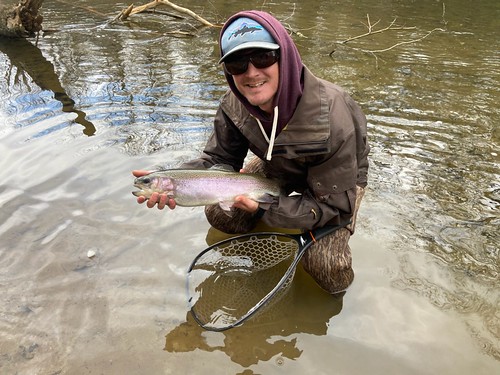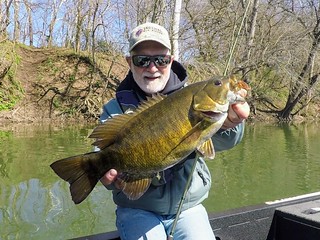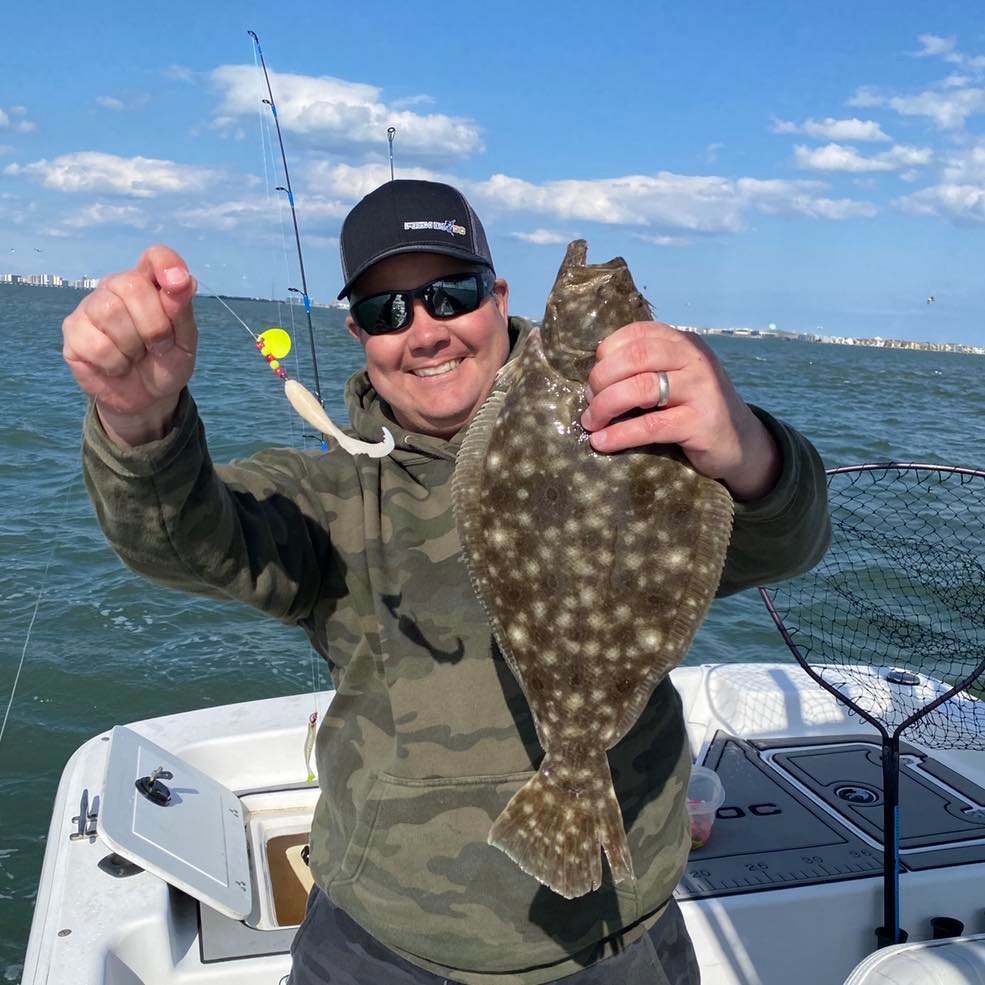
Brent Fletcher took his opportunity to fish the upper Patapsco River and catch this beautiful rainbow trout. Photo courtesy of Brent Fletcher
March finished with some cold and blustery conditions for anglers, and April promises milder temperatures. Trout fishing in the put-and-take areas has been getting the premier attention of many anglers enjoying the daily and generous stocking of trout, which will last through the month of April. Don’t miss it!
As a reminder, Maryland waters of the Chesapeake Bay and tributaries except the Potomac River remain closed to all striped bass catch-and-release fishing until May 1. Anglers should become familiar with areas that will open May 1 and later season change dates using the Maryland Department of Natural Resources online striped bass regulation map.
In the meantime, fishing in Maryland for multiple species abounds in April.
Forecast Summary: April 6 – April 12:
The moderate and wet weather for the next few days will continue to slowly warm Maryland waters for gamefish including shad and herring, which are spawning or preparing to spawn in the next couple of weeks. Chesapeake Bay surface water temperatures have risen to the upper 40s and low 50s. Smaller streams and downwind areas on a sunny day will warm faster and can hold water temperatures in the mid to upper 50s. Such areas where there is also low salinity will be prime to look for shad and herring on their spawning runs.
Expect average flows for most Maryland rivers and streams this week, with localized higher flows due to predicted rains Wednesday through Friday. Expect average water clarity in the Bay, with some reduced water clarity in some rivers following rains Wednesday through Friday. To see the latest water clarity conditions, check Eyes on the Bay Satellite Maps.
There will be above average tidal currents Wednesday as a result of the April 1 new moon.
As always, best fishing areas could be further refined by intersecting them with underwater points, hard bottom, drop-offs, and large schools of baitfish.
For more detailed and up-to-date fishing conditions in your area of the Bay, be sure to check out Eyes on the Bay’s Click Before You Cast.
Upper Chesapeake Bay

Art Cohen holds a huge white perch. Photo by Ivan R. Cohen
Water flows from the Conowingo Dam have been slower lately and the wind finally decided to take a rest. Anglers are able to get out on the water and enjoy clear and calm water conditions. Blue catfish are the big draw and there are plenty being caught by anglers using everything from fresh cut bait to pieces of chicken. White perch are showing up in the lower Susquehanna River this week and hickory shad are starting to make their presence known in the river and near the mouth of Octoraro Creek. Shad restoration biologists doing survey work reported seeing hickory shad in the Patapsco River last week. It is still early for good hickory shad fishing but for those that can’t wait there is some opportunity. Brightly colored shad darts and small spoons are popular lures to cast.
Now that the catch-and-release of striped bass is closed, many anglers are focusing on fishing for blue and channel catfish in the Bay and the tidal rivers. Every tidal river has a population of both species and the blue catfish are rapidly expanding their range. At this time the lower Susquehanna River and the upper Chester River hold the greatest populations of blue catfish.
Post-spawn and pre-spawn white perch are being found in the middle sections of the region’s tidal rivers and creeks, providing some light-tackle action. The lower Susquehanna River white perch fishery is just beginning. Casting small jigs and beetle-spins are productive in the deeper parts of the creeks. Fishing with a bottom rig baited with pieces of bloodworm tends to be the most productive way to fish the deeper parts of the tidal rivers.
Middle Bay

Photo courtesy of Anthony Williams
The white perch are moving their way down the region’s tidal rivers this week and can provide some good fishing if you can find them. They tend to be in relatively deeper waters. Jigging with small jigs and shad darts can be productive when the perch can be found suspended off the bottom. Tipping the jigs or shad darts with a small piece of bloodworm or grass shrimp can work wonders when jigging close to the bottom. Fishing with a bottom rig baited with pieces of bloodworm is a tried-and-true method of catching white perch. Grass shrimp also work well if you can acquire some.
A mix of channel catfish and blue catfish are available in the tidal rivers of the middle Bay. Channel catfish are found in all of the tidal rivers and the Choptank River holds the greatest number of blue catfish at this time. Blue catfish populations are expanding at a very rapid rate and filling in everywhere conditions are favorable for them. Those that weigh 20 pounds or less make for good eating if you know how to filet and prepare them. Removing all of the red meat and silver skin will leave you with a very mild-tasting filet that also freezes well.
Anglers are using a variety of baits to fish for channel and blue catfish; selections range from fresh cut bait of white perch, gizzard shad, or menhaden and clam snouts, to chicken liver, gizzards, and breast meat. All seem to work fairly well, it seems like everyone has their own favorite concoction. Large circle hooks tied into a bottom rig, weighted with a fish finder rig or sliding egg sinker, help to allow the catfish to hook themselves when swimming away. This gives you plenty of time to pick up the rod and engage the drag or take the reel out of free spool, and the catfish are always hooked in the corner of the mouth.
Lower Bay
In the lower Bay most of the fishing opportunities are in the tidal rivers. The catching and releasing of striped bass is curtailed until May 1 except in the Potomac River. Anglers that are out fishing are focused on blue catfish, white perch, and northern snakeheads, and a few are sampling the beginning stages of the hickory and American shad spawning runs.
Blue catfish can be found in great numbers in the tidal Potomac River from the District of Columbia line south to the Route 301 Bridge. The epicenter of fishing activity tends to be in the Wilson Bridge-Fort Washington area. The Patuxent River also has a large population of blue catfish and some of the best fishing opportunities are from Benedict to Jug Bay. On the Nanticoke River there are a lot of blue catfish in the Sharptown-Marshyhope Creek section of the river. The Wicomico River also has an expanding population of blue catfish, and anglers report catching blue cats from the junction of Wicomico Creek up to Salisbury. The Chicamacomico River is also documented to have blue catfish.
Our southern region biologists have been studying blue catfish for years and have learned a lot about them. Blue catfish are considered an invasive species throughout the Chesapeake Bay and its tributaries. The species is native to the Midwest, and the opportunistic feeder can grow to more than 100 pounds. It has quickly spread throughout the region and their effects on native fisheries and aquatic ecosystems are unknown.
To address these concerns, DNR along with the United States Geological Survey and the Atlantic States Marine Fisheries Commission, are researching diet and movement habits of the species in the Patuxent River. The fish has only recently been found in the river, and it offers an opportunity to learn how best to manage and control the species, as it spreads throughout the state.

This picture shows a large number of blue catfish that were stunned with electrofishing gear in the Patuxent River. Photo by Mary Groves
During the winter of 2019-2020, biologists examined the stomachs of nearly 500 blue catfish from the tidal Patuxent River. Fish ranged from 12.5 inches to 41 inches in length and were up to 40 pounds in weight. Mud crabs were the most abundant prey item found, but fish accounted for the most biomass in blue catfish stomachs. Other species found in their diet included American eels, blue crabs, and white perch. Work will continue to examine seasonal and spatial differences in the diets of the fish.
You can read the results from the Blue Catfish Study on the DNR website.
White perch are moving down all of the region’s tidal rivers and generally can be found a few miles below the spawning areas, often in the deeper parts of the rivers and creeks. Jigging with small shad darts and jigs tipped with a piece of bloodworm, minnow, or better yet a grass shrimp will get you into the action. Bottom rigs baited with the same work extremely well in the deeper channel edges.
Northern snakeheads are beginning to stir and can now be found in shallower waters during sunny afternoons. Every tidal river and creek in the lower Bay holds populations of northern snakeheads. Casting white paddle tails near shallow structure is a good tactic, but perhaps one of the most effective methods this time of the year is to fish a large minnow under a popping cork or bobber. Often anglers will dead-stick this minnow rig while casting to the shallows. The DNR website has an abundance of information about northern snakeheads.
Hickory shad are starting to show up in the upper Patuxent and in the Potomac at the Chain Bridge section in the District of Columbia. This catch-and-release fishery provides a lot of fun for anglers. American shad are beginning to arrive in the Potomac also and a few have been reported by anglers. A variety of brightly colored shad darts are the preferred lures used.
Freshwater Fishing
Put-and-take trout anglers are enjoying the fruits of the generous trout stockings that are taking place every week this month. Water flow conditions have been very good and although it has been a bit nippy out, everyone seems to be having fun. There are some special waters set aside for youth and blind anglers only and others that additionally allow seniors 65 or older. Other areas are set for catch-and-release and gear restrictions such as no bait or fly fishing only.
The upper Gunpowder Falls is an example where fly fishing anglers enjoy stalking brown trout at this world class catch-and-return trout fishery. Right now the Gunpowder Falls waters below Prettyboy Reservoir are flowing well with water temperatures in the middle 40s. Locals report that black stoneflies are emerging to create a dry fly fishery. To broaden your trout fishing horizons be sure to check out the trout stocking pages, including trout management maps, on the DNR website.

John Mullican holds up a beautiful smallmouth bass for a photo op before slipping back in the Potomac. Photo courtesy of John Mullican
The upper Potomac River is flowing well this week with water temperatures in the low 50s. It would be easy to say that conditions are perfect for fishing for smallmouth bass and muskellunge. Tubes have been a very popular bait for smallmouth bass, and a variety of large spinnerbaits and soft plastics for the muskellunge.
Fishing for largemouth bass continues to be good as the bass feed aggressively while they enter their pre-spawn phase of building up body stores. The waters of tidal rivers, reservoirs, and ponds are still fairly cold, so some of the best largemouth bass fishing can occur on the sunny afternoon waters where the largemouth are seeking warmer water.
Casting a variety of lures in these shallower areas is a good tactic in the afternoon hours; tubes, paddle tails, jerkbaits, spinnerbaits, and lipless crankbaits are all good choices. In the morning hours or cloudy days the bass may hold to deep structure along drop-offs – sunken wood, fallen treetops, dock piers, and bridge piers all fit the bill. Working wacky-rigged worms and jigs near these types of structure can entice the largemouth to strike.
Crappie fishing is excellent this time of the year whether fishing in tidal waters of a local pond or reservoir. Structure is often the key and anything from fallen treetops or brush to marina docks and bridge piers will attract them. It is pretty hard to beat a small minnow under a slip bobber, but small marabou jigs can also work well.
Atlantic Ocean and Coastal Bays

Scott Lenox is all smiles as he holds up his first flounder of the 2022 season. Photo courtesy of Scott Lenox
Despite cold winds and rather rough conditions at times, the inshore coastal fisheries at Ocean City are beginning to take shape. Tautog are being caught near jetty rocks, the Route 50 Bridge piers, and nearby bulkheads and dock areas. A fair percentage are measuring above the minimum size of 16 inches and providing plenty of fun fishing. Sand fleas and pieces of green crab are popular baits. The first flounder of the season are being caught in the back bay areas by those persistent enough to brave chilly temperatures to fish for them.
Striped bass are providing plenty of legal catch-and-release action in and around the inlet, the Route 50 Bridge, the commercial harbor, and the Route 90 Bridge. Casting soft plastic jigs and paddle tails has been a popular way to fish for them. Outside the inlet at the offshore wreck and reef sites, tautog are being caught when the boats get a calm day.
“I can never tell exactly when I stop hearing the river; it fades and fades, but is still there. Then suddenly it is there no longer and the silence is much louder than the river ever was.” – Louise Dickinson Rich
Maryland Fishing Report is written and compiled by Keith Lockwood, fisheries biologist with the Maryland Department of Natural Resources.
Click Before You Cast is written by Tidewater Ecosystem Assessment Director Tom Parham.
This report is now available on your Amazon Echo device — just ask Alexa to “open Maryland Fishing Report.”
